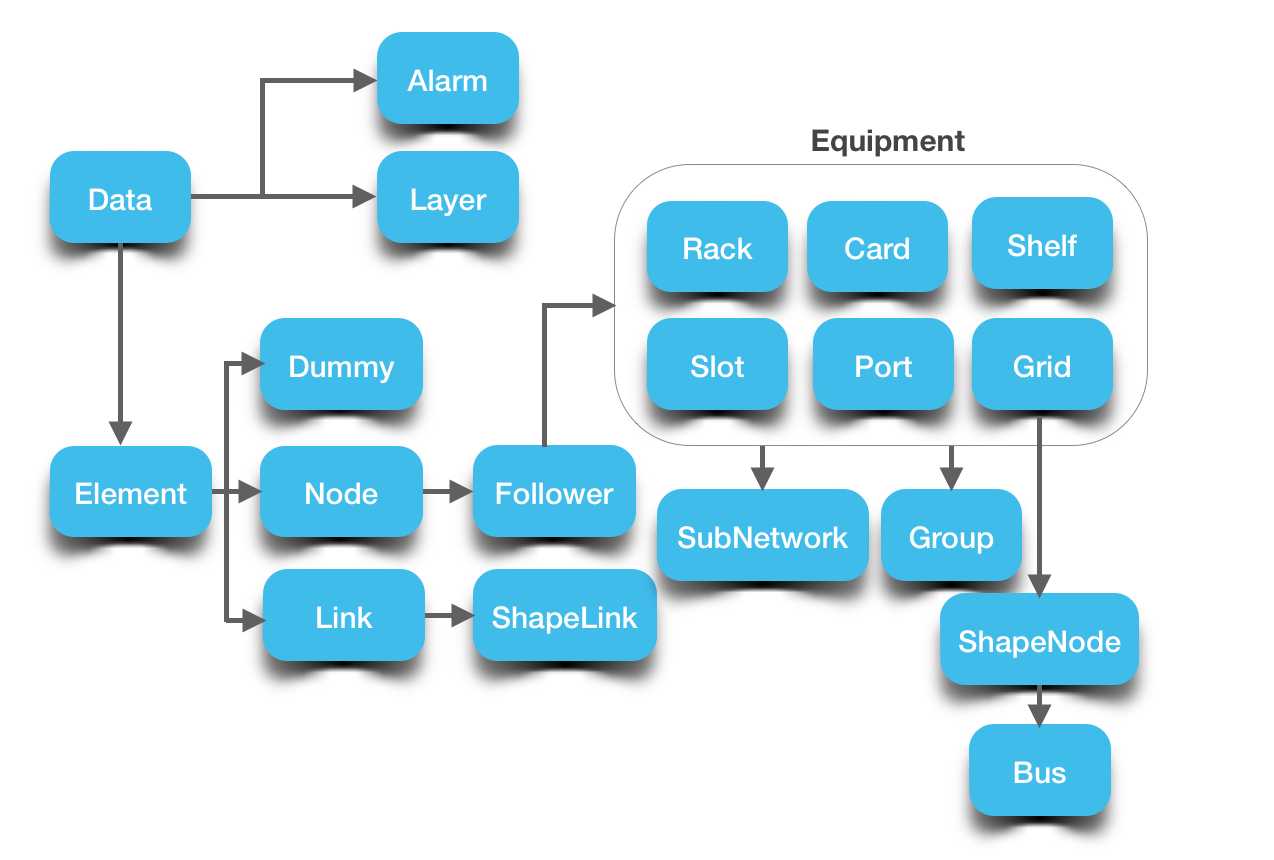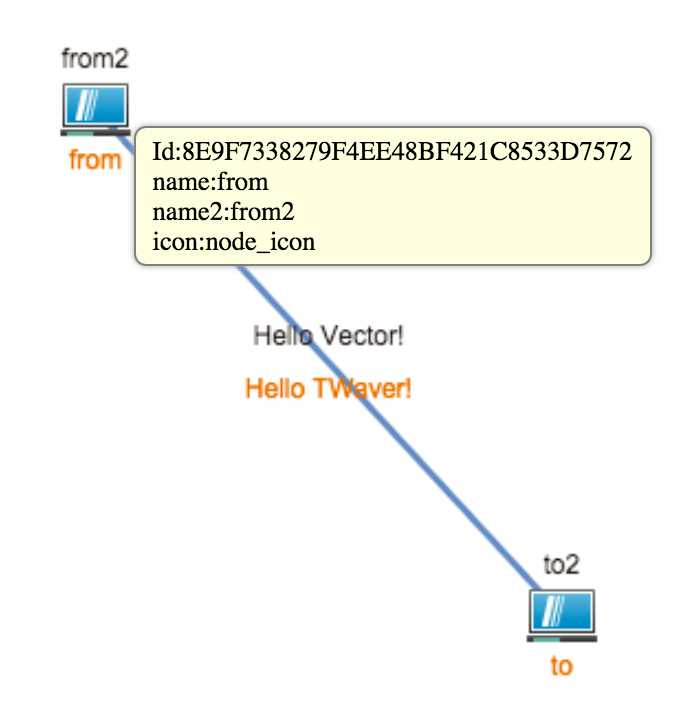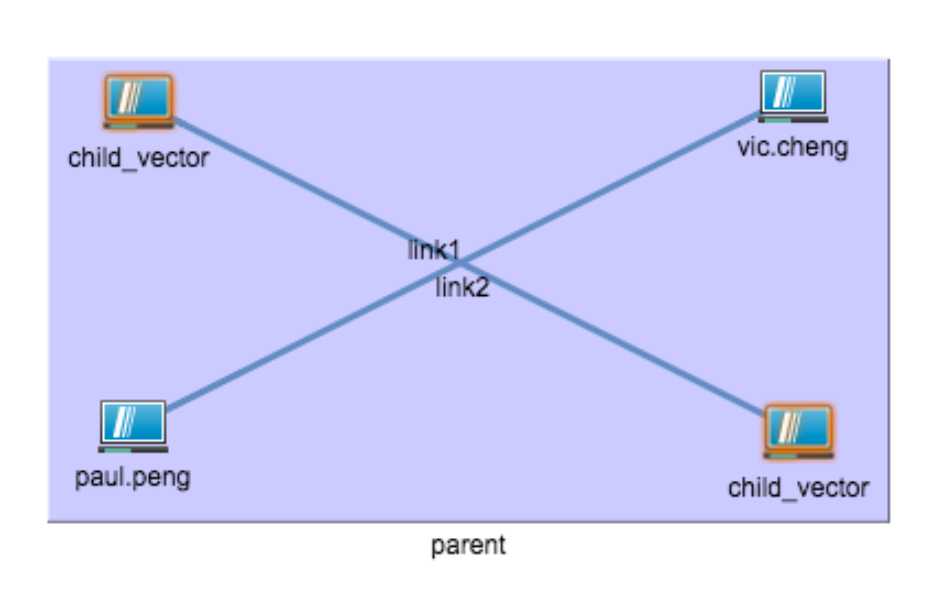标签:
数据元素是数据模型的基本要素,用于描述图形网元,业务网元,或者纯数据。TWaver HTML5中所有数据元素都继承自twaver.Data。为不同功能的需求,预定义了三类数据类型:twaver.Element,twaver.Alarm,twaver.Layer,分别用来描述拓扑的网元,告警和图层。其中拓扑网元扩展定义了十几种网元类型,用以描述丰富的拓扑网元特性,其中最常用的几类拓扑网元包括:Node、Link、Group、SubNetwork、Grid等,TWaver中网元的继承关系如下图,本章将详细介绍这些网元以及其他数据类型的特性,使用以及扩展应用。

twaver.Data是TWaver HTML5中最基本的数据元素,默认定义了id,name,name2,icon,toolTip,parent,children等基本属性,支持事件派发和监听,由它扩展出来还有twaver.Element,twaver.Alarm,twaver.Layer等数据类型。
twaver.Data继承于twaver.PropertyChangeDispatcher类,内部包含一个twaver.EventDispatcher实例对象,这使得Data具有派发事件和监听事件的功能,可以通过调用下面的方法派发事件或者添加监听器:
//派发属性变化事件 firePropertyChange:function(property,oldValue,newValue) //添加属性变化监听器 addPropertyChangeListener:function(listener,scope,ahead) //删除属性变化监听器 removePropertyChangeListener:function(listener) //属性发生变化的处理方法 onPropertyChanged:function(listener)
定义了一些基本属性,包括id,name,name2,icon,toolTip等。
/** *id:网元的id,如果未设置,TWaver内部会分配唯一的Id。 */ twaver.Data:function(id) getId:function() setName:function(value) getName:function() setName2:function(value) getName2:function() setIcon:function(value) getIcon:function() setToolTip:function(value) getToolTip:function()
Note:name2为新增加的属性,增大了label设置的灵活性。
如果需要设置其他属性,可以通过setClient()/getClient()方法设置自定义的属性(包括对象)。
//设置Client属性; setClient = function(clientProp,newValue) //获取Client属性 getClient = function(clientProp)
Note:setClient()存放数据类似于Java中的HashMap。
示例:
var box = new twaver.ElementBox(); var network = new twaver.vector.Network(box); function init() { initNetwork(); initDataBox(); } function initNetwork() { var view = network.getView(); document.body.appendChild(view); network.adjustBounds({x: 0, y: 0, width: 1300, height: 600}); network.getToolTip = function (element) { var Id = element.getId(); var name = element.getName(); var name2 = element.getName2(); var icon = element.getIcon(); var clientProperty = element.getClient(‘clientProperty‘); return ‘Id:‘ + Id + ‘ ‘ + ‘name:‘ + name + ‘ ‘ + ‘name2:‘ + name2+ ‘ ‘ + ‘icon:‘ + icon; } twaver.Styles.setStyle(‘label.color‘,‘#ec6c00‘); twaver.Styles.setStyle(‘label2.color‘,‘#57ab9a‘); twaver.Styles.setStyle(‘select.color‘,‘#ef8200‘); } function initDataBox() { var node = new twaver.Node({ name: ‘from‘, name2: ‘from2‘, location: { x: 300, y: 200 } }); box.add(node); var node2 = new twaver.Node({ name: ‘to‘, name2: ‘to2‘, location: { x: 500, y: 250 } }); box.add(node2); var link = new twaver.Link(node, node2); link.setName(‘Hello TWaver!‘); link.setName2(‘Hello Vector!‘); link.setClient(‘clientProperty‘,node); box.add(link); }

Note:从示例中我们学会了什么?
在这我们特别列举出icon的布局问题,icon作为网元的附件可以围绕在网元的周围,呈现一些特殊信息。TWaver支持多组icon同时存在,且摆放的位置可以分别设置。下面列举使用方法:
function registerImage(){ registerNormalImage(‘./images/list_view.png‘,‘list_view‘); registerNormalImage(‘./images/settings1.png‘,‘setting1‘); registerNormalImage(‘./images/ic_mech_wheel.png‘,‘wheel‘); registerNormalImage(‘./images/ic_search_archive.png‘,‘archive‘); registerNormalImage(‘./images/super_mono.png‘,‘mono‘); registerNormalImage(‘./images/twitter_04.png‘,‘twitter‘); } function registerNormalImage(url, name) { var image = new Image(); image.src = url; image.onload = function() { twaver.Util.registerImage(name, image, image.width, image.height); image.onload = null; network.invalidateElementUIs(); }; } function initNode() { var node2 = new twaver.Node("node2"); node2.setLocation(450, 205); box.add(node2); node2.setName(‘name1‘); node2.setName2(‘name2‘); node2.setSize(300,300); node2.setStyle(‘icons.names‘, [["mono","wheel",‘archive‘],["wheel",‘archive‘,‘mono‘],["archive",‘mono‘],["mono",‘wheel‘]]); node2.setStyle(‘icons.position‘, [‘topleft.topleft‘,‘topright.topright‘,‘bottomleft.bottomleft‘, ‘bottomright.bottomright‘]); node2.s(‘icons.orientation‘,[‘top‘,‘left‘,‘right‘,‘bottom‘]); }

此外,Data中还定义了其他功能函数
//获取所有子网元 getChildren:function() getChildSize:function() //获取符合macthFunction的所有childs组成的List toChildren:function(macthFunction,scope) addChild:function(child,index) removeChild:function(child) getChildAt:function(index) clearChildren:function() getParent:function() setParent:function(parent) hasChildren:function() isRelatedTo:function(data) isParentOf:function(data) isDescendantOf:function(data)
//toChildren:function(macthFunction,scope)的使用方法 parent.toChildren(function(e){ return e.getName() === ‘vector‘; });
var box = new twaver.ElementBox(); var network = new twaver.vector.Network(box); function init() { initNetwork(); registerImage(); initDataBox(); } function initNetwork() { var view = network.getView(); document.body.appendChild(view); network.adjustBounds({x: 0, y: 0, width: 1300, height: 600}); twaver.Styles.setStyle(‘select.color‘, ‘#57ab9a‘); } function registerImage() { //register shadow twaver.Util.registerImage(‘shadow‘, { w: 37, h: 29, shadowOffsetX: 0, shadowOffsetY: 0, shadowBlur: 5, shadowColor: ‘#ec6c00‘, v: [ { shape: ‘vector‘, name: ‘node_image‘, x: 0, y: 0 } ] }); } function initDataBox() { var parent = new twaver.Group({ name: ‘parent‘, location: {x: 300, y: 400 }, }); box.add(parent); var node1 = new twaver.Node({ name: ‘Jeff.fu‘, location: { x: 200, y: 200 } }); node1.setClient(‘vector‘, true); box.add(node1); var node2 = new twaver.Node({ name: ‘alex.dong‘, location: { x: 500, y: 350 } }); node2.setClient(‘vector‘, true); box.add(node2); var node3 = new twaver.Node({ name: ‘paul.peng‘, location: { x: 200, y: 350 } }); box.add(node3); var node4 = new twaver.Node({ name: ‘vic.cheng‘, location: { x: 500, y: 200 } }); box.add(node4); var link = new twaver.Link(node1, node2); link.setName(‘link1‘); link.setStyle(‘label.position‘,‘topleft.topleft‘); box.add(link); var link2 = new twaver.Link(node3, node4); link2.setName(‘link2‘); box.add(link2); parent.addChild(node1); parent.addChild(node2); parent.addChild(node3); parent.addChild(node4); matchFunction = function (e) { if (e.getClient(‘vector‘)) { return true; } } var childrenMatch = parent.toChildren(matchFunction); childrenMatch.forEach(function (element) { element.setImage(‘shadow‘); element.setName(‘child_vector‘); }); }

Note:上述示例我们学会了什么?
标签:
原文地址:http://www.cnblogs.com/ClassNotFoundException/p/5849031.html